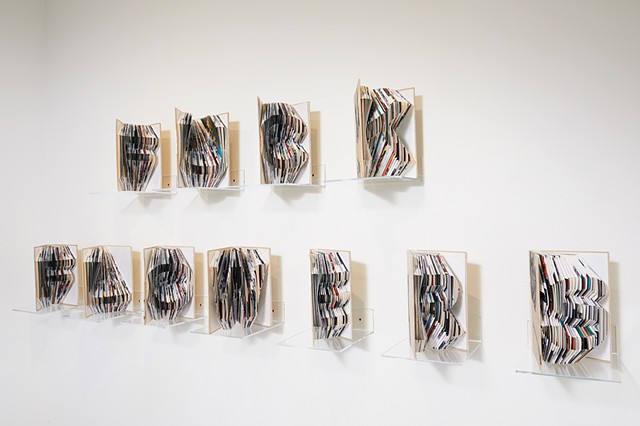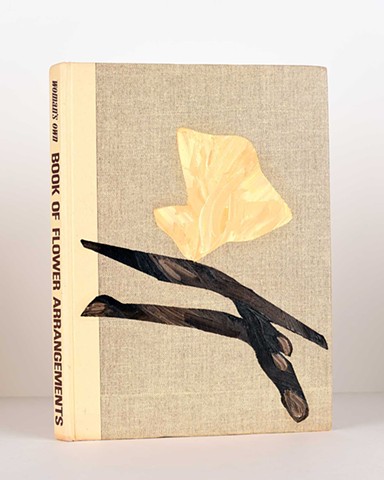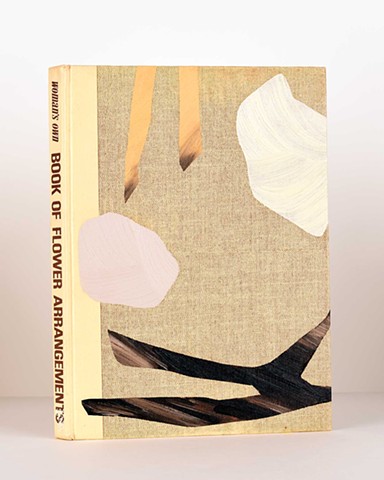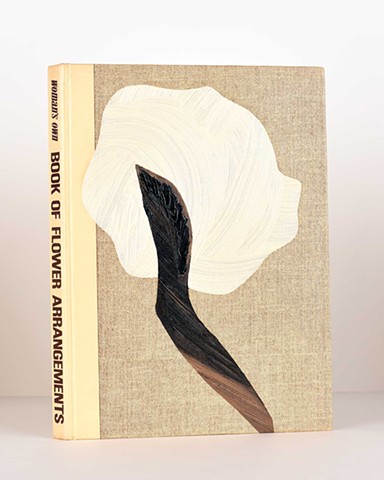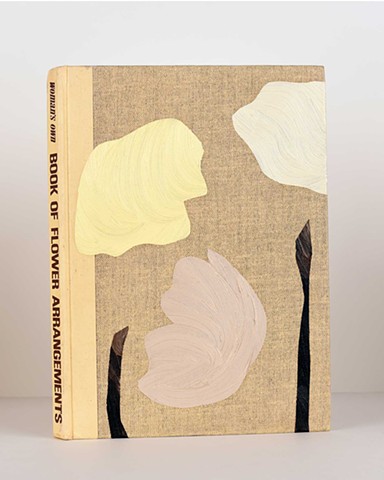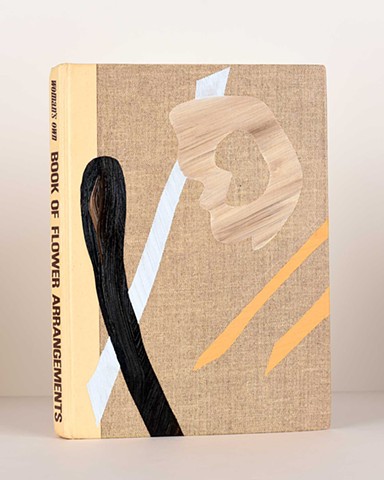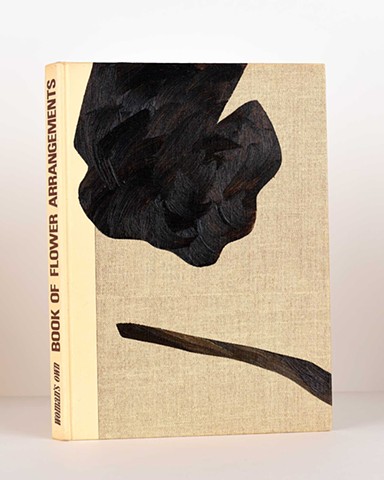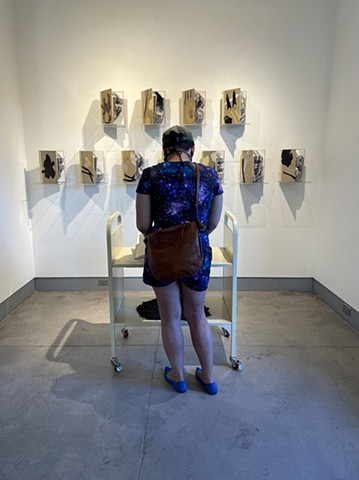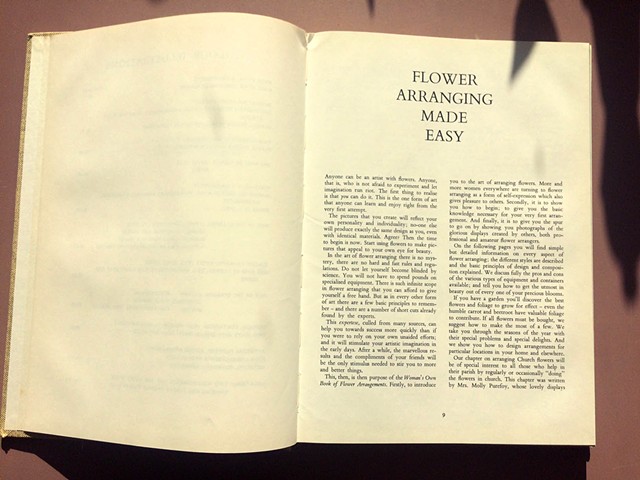Paintings For Our Mothers
see information text below images
I gratefully acknowledge the support of the Canada Council for the Arts.
Paintings For Our Mothers
“More and more women everywhere are turning to flower arranging as a form of self-expression which also gives pleasure to others.”
[Woman’s Own Book of Flower Arrangements, 1966, p.9].
I am a visual artist who predominantly paints. When I discovered this vintage book I was attracted to the linen-like book cover as a canvas. I collected multiple copies still in circulation. The result is Paintings For Our Mothers, a series of eleven painted-on books of abstract, flat cut-out flower and twig forms. Each painted book’s pages are variously folded in on themselves, turning each one into a sculptural piece.
On first reading the book’s title, Woman’s Own Book of Flower Arrangements (also printed on the book’s spine), I was at the same time amused and annoyed. It sounded dated and a bit condescending and somewhat anti-feminist. And yet I learned that the book’s British publisher still puts out Woman’s Own, a UK weekly magazine first published in 1932 that “placed women's rights and social problems firmly in the foreground.“ (Wikipedia).
Flower arrangement is a major art form in Japan (Ikebana). I wondered why this activity was geared to Western women, and to housewives in particular, as a “hobby”. Flower arranging was the only creative course I recall my mother took when I was growing up. Many Woman’s Own flower arrangements themselves are black and white photos, but even those in color look stilted and stifled. They made me think of the boxed-in life as a housewife, with such limited opportunities for women during the sixties.
Using a collage-like system, I devised new compositions featuring cut-outs of individual flower and stem shapes depicted in the book, or of part or all of a flower arrangement. I taped off these outlines on the book covers, yielding hard edges whose areas I filled in with brush strokes, textured paint and mediums. I chose a palette of earth colors rooted in the Southwest surroundings where I currently live (Santa Fe, New Mexico).
My intent is to unfold/refold, create new arrangements in an updated space, altering, transforming and recycling the medium of the book in order to subvert its message. The text element in the series is comprised of each book’s bound pages folded into the shape of a letter that invites the viewer into its inner arrangements. All the letters of the eleven painted-on books combine to spell out “FUCK FLOWERS”– a response some women today might feel on receiving a rose from a potential suiter. (In some feminist circles men giving women flowers is viewed as patronizing). But the book’s superficial take on flowers has a broader subtext, namely its approach to nature itself.
As I created these works over the past five years—each year a new forewarning of global warming—I became more conscious of the disconnect with nature in this book of flower arrangements published some four years before the first Earth Day in 1970. Viewed today against nature’s new normal of global warming and climate change, the book’s arrangements of cut (dead) flowers underscore their ironic reference to nature morte, in which the ‘still life’ is a paean to earth’s beauty as well as a portent of its possible demise.
Paintings For Our Mothers deconstructs and subverts society’s false narratives on the status of women and the state of nature. Its images serve as both harbinger and hope, they speak to our capacity as a society to fix what is broken, to rearrange and to heal.
These paintings are for my mother, for all our mothers, and for Mother Earth.
Doreen Wittenbols, 2021
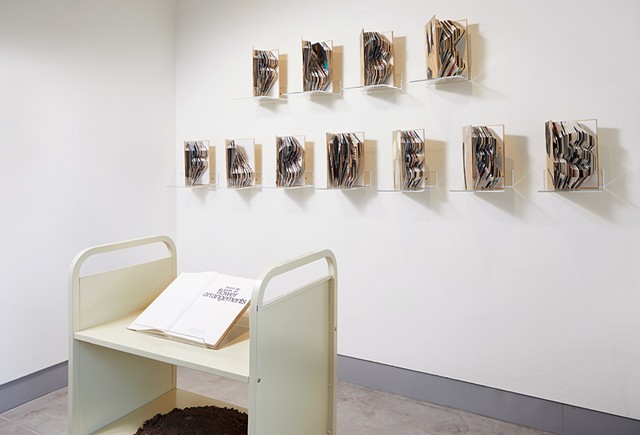
![Paintings For Our Mothers I [alternate view]](http://img-cache.oppcdn.com/fixed/843/assets/kqzyYp2vualUi8Hb.jpg)
![Paintings For Our Mothers II [alternate view]](http://img-cache.oppcdn.com/fixed/843/assets/Ou7SMKTOGejTUK8s.jpg)
![Paintings For Our Mothers III [alternate view]](http://img-cache.oppcdn.com/fixed/843/assets/nyeMpPpBRF_Z3EDK.jpg)
![Paintings For Our Mothers IV [alternate view]](http://img-cache.oppcdn.com/fixed/843/assets/tPtBgXAHBHjgcFJd.jpg)
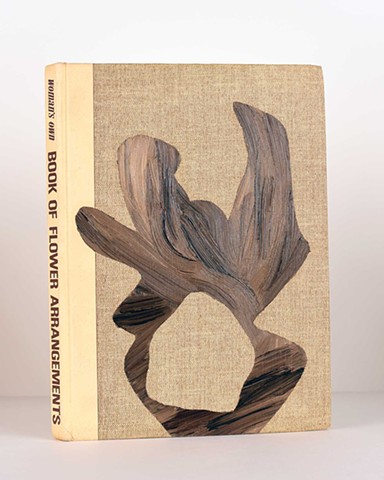
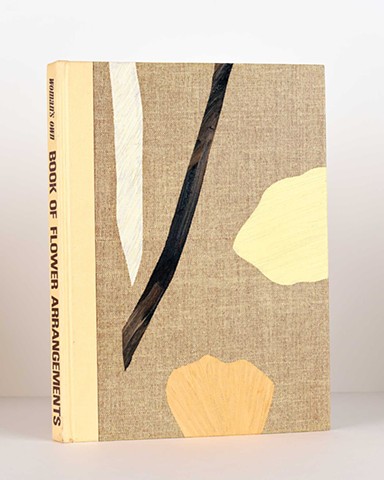
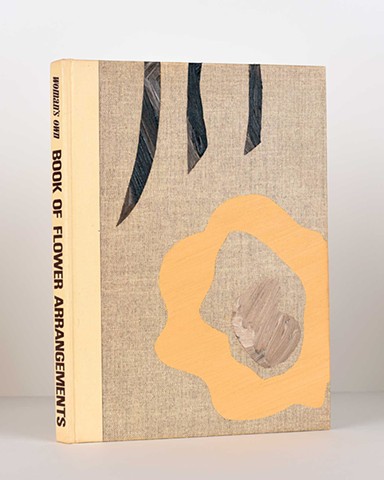
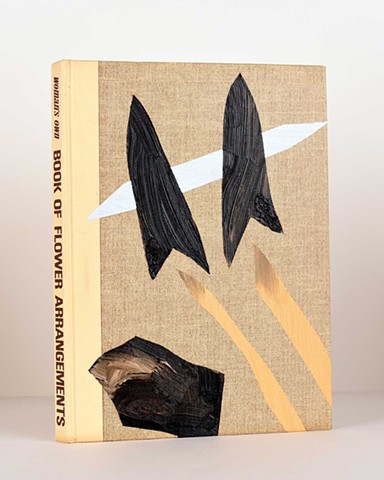
![Paintings For Our Mothers V [alternate view]](http://img-cache.oppcdn.com/fixed/843/assets/yOf2h9f_sYeJbria.jpg)
![Paintings For Our Mothers VI [alternate view]](http://img-cache.oppcdn.com/fixed/843/assets/vSFRzTCaTYi8aatD.jpg)
![Paintings For Our Mothers VII [alternate view]](http://img-cache.oppcdn.com/fixed/843/assets/V1Vn_9l6M90QHgph.jpg)
![Paintings For Our Mothers VIII [alternate view]](http://img-cache.oppcdn.com/fixed/843/assets/0BrJC0fe0n8Kgoe4.jpg)
![Paintings For Our Mothers IX [alternate view]](http://img-cache.oppcdn.com/fixed/843/assets/nVvpz1rbGxDg9i8a.jpg)
![Paintings For Our Mothers X [alternate view]](http://img-cache.oppcdn.com/fixed/843/assets/vn8JzgEwWYSLVzcK.jpg)
![Paintings For Our Mothers XI [alternate view]](http://img-cache.oppcdn.com/fixed/843/assets/pZy8oDaTHhxdEVV1.jpg)
